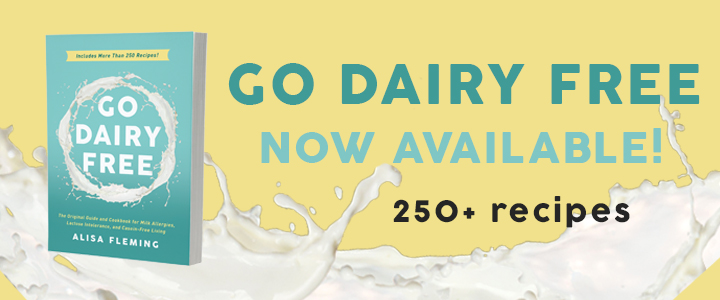57
By Alisa Fleming onDairy-Free FAQs, In The News, News
I originally covered the topic of non dairy vs dairy free over a decade ago, when I received the following question from a Go Dairy Free reader named Donna.
I have a non-dairy creamer that has sodium caseinate (a milk derivative) and have noticed many other commercial brand non-dairy creamers with this ingredient. Does this make it still a dairy product? If so, how can it be called non dairy if it contains milk and isn’t dairy free?
The answer isn’t cut and dry, and has actually changed a little over the years. So I’m updating this post with the latest information, straight from the Food & Drug Administration (FDA).

Non Dairy vs Dairy Free: Why One May Contain Milk
By definition, “non” means “not”, so we would assume that a non-dairy product would not contain dairy. Unfortunately, this isn’t always the case due to some confusing labeling that the FDA permits.
How the Non-Dairy Conundrum Began
Many years ago, the FDA created a regulatory definition for the term non-dairy. It stated that a product labeled as non-dairy can contain 0.5% or less milk by weight, in the form of casein / caseinates (milk protein). The idea wasn’t to protect dairy-free consumers, but to prevent dairy consumers from mistaking very low-milk, dairy-like foods for dairy products.
What Non-Dairy Means Today
The FDA eventually retracted their official non-dairy definition, but they still have a general stance on what it means. A representative for the FDA provided the following “non-dairy response” to us in 2019.
We do not have a definition for the term [nondairy]in our regulations for food labeling. However, we do not consider the terms “nondairy” and “dairy free” to be equivalent. We have interpreted the term “dairy free” as meaning the complete absence of all dairy ingredients including lactose, etc. The term “nondairy” refers to products, such as nondairy whipped topping and nondairy creamers, that may contain a caseinate milk derivative.
What Dairy-Free Means
The FDA has never had a definition for the term dairy-free. As mentioned above, they have a general interpretation of the term, but they do not enforce or regulate it.
However, the FDA does state that labeling must be truthful and cannot be misleading. Consequently, consumers should be able to initially assume that a dairy-free product is made without dairy ingredients. You must then read the ingredient label to be sure. If you see the term dairy-free on a product that contains any type of milk in the ingredients, you are urged to notify the company and contact the FDA.
Remember that these labels address ingredients, not processes. If you are dealing with a severe milk allergy or other highly sensitive dairy concern, you must also contact the manufacturer to discuss their processes. The term dairy-free typically refers to the ingredients themselves, not the processes and potential allergen cross-contamination in manufacturing.
Non-Dairy Products are Often Dairy Free
Contrary to the FDA wording in their response above, most products labeled as “non-dairy” are in fact dairy-free by ingredients. Many companies choose to use the term non-dairy instead of dairy-free for a variety of reasons. Some say this label is more familiar and less intimidating to consumers. Others fear liability from using a “free from” term of any kind.
The “non-dairy” products that most often contain a small amount of casein (milk protein) are foods that we would think of as “dairy” products, like whipped toppings and creamers. Even then, most of the new “non-dairy” toppings, milk beverages, and creamers are made without any dairy ingredients. As time goes on, we’re seeing the terms non-dairy and dairy-free used more interchangeably.
Non-Dairy Foods and Allergen Labeling Laws
Although the term “non-dairy” may be misleading, food manufacturers cannot “hide” dairy in the ingredients. Our friends at the FDA shared this somewhat convoluted explanation of the requirements with us, but hopefully, you get the gist.
When foods characterized on the label as “nondairy” contain a caseinate ingredient, the caseinate ingredient must be followed by a parenthetical statement identifying its source. If the manufacturer uses the term “nondairy” on a creamer that contains sodium caseinate, it must include a parenthetical term such as “a milk derivative” after the listing of sodium caseinate in the ingredient list. (Reference: 21 CFR 101.4(d)).
In addition, milk and ingredients derived from milk such as casein (a milk protein) are major food allergens. Federal law requires the source of sodium caseinate to be indicated in the ingredient statement of a label, e.g., “sodium caseinate (milk).” Alternatively, the source of this ingredient may be indicated in a contains statement immediately after or adjacent to the ingredient statement, e.g., “Contains: milk.”
Tips for Finding Dairy-Free Non-Dairy Products
Look for Trusted Brands – Read ingredients, check websites, and call if necessary to find reliable dairy-free companies. Over time, you will probably find some beloved dairy-free companies that consistently provide you with the foods your craving. For those tricky non-dairy foods, I do have a Dairy-Free Coffee Creamer Guide and a Dairy-Free Whipped Topping Guide.
See the Dairy-Free Signs – To save time, scan packaging for labels that elude to a truly dairy-free product. As shown on the image of So Delicious Dairy Free CocoWhip Topping below, “dairy free” can be a good indicator, especially if it’s in the brand’s name! The Kosher Parve certification also denotes a product made without dairy. Finally, a product should not be labeled as “vegan” (though mistakes have happened) if it contains any dairy. When you spot what looks like a winner, double check the ingredients, and if needed, contact the company to inquire on their allergen processes.


